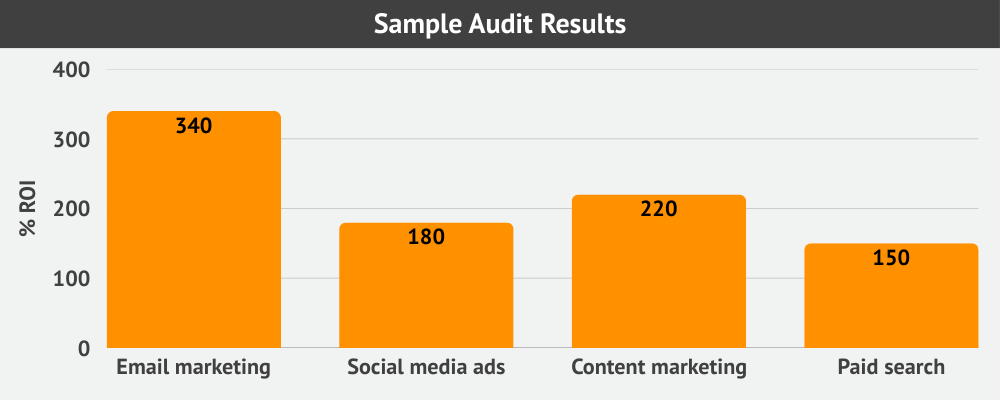
Quick Summary
- Fall marks the ideal season for marketing professionals to reset and refocus their strategies
- These 15 fast, actionable tasks help busy marketers assess business health without major time investment
- From customer experience testing to team alignment, each task delivers maximum impact for minimal effort
- Perfect for Q4 prep and identifying opportunities to finish the year strong
Summer’s over. The team’s back from vacation, inboxes are full, and Q4 deadlines are already pressing in. But along with the backlog comes a burst of post-summer energy—the perfect moment to channel momentum instead of just catching up.
Think of it as fall cleaning for your marketing: clearing out clutter, doubling down on what’s working, and fine-tuning your strategy before the year-end sprint.
These 15 clever marketing mini-tasks each take just a few minutes. On their own, they’re simple tune-ups. Together, they’ll give you a sharper picture of where your business stands—and the momentum you need to finish the year strong.

15 Quick Marketing Tasks to Assess Your Business
1. Call your own support line
Pick up your phone right now and dial your customer service number. Experience the hold music, the transfer process, and the actual help quality your customers receive daily.
What to test:
- Wait times. How long before a human answers?
- Tone and helpfulness. Does the rep sound engaged or rushed?
- Problem resolution. Can they actually solve a basic issue?
This simple exercise reveals disconnects between marketing promises and customer reality. If your ads claim “award-winning support” but customers wait 20 minutes for grumpy assistance, you’ve found your first fix.
2. Sign up for your own emails
Create a new email address and subscribe to your marketing list. Watch what happens over the next two weeks.
Evaluation criteria:
- Frequency balance. Are you sending helpful content or just noise?
- Design functionality. Do emails render properly across devices?
- Call-to-action clarity. Can subscribers easily understand next steps?
Many marketing teams never see their own email experience. This customer perspective often uncovers formatting disasters, broken links, or messaging that sounds completely different from your intended tone.
3. Google your company like a stranger
Open an incognito browser window and pretend you’re a potential customer. Google search phrases like:
- [“Your brand] + reviews”
- “Your product + comparison”
- “Your company name”
What to look for:
- Do trusted third-party results show up?
- Are the headlines and meta descriptions compelling?
- Are there outdated or off-brand search results?
- This gives you an unfiltered view of your brand’s online footprint.
4. Skim your latest blog posts (as a prospect)
Look at the past three blog posts published. Ask yourself:
- Would a non-expert understand this?
- Does this actually help solve a problem?
- Is there a CTA that makes sense for someone in the awareness stage?
Make sure you’re posting content that isn’t about what you want to say but what your audience needs to hear.

5. Check your last 5 social posts
Open your social feeds and look at your company’s last 5 posts.
Ask yourself:
- Do they align with your brand voice and values?
- Would you stop scrolling for any of them?
- Is there variety (not just links or promos)?
Social media isn’t set-it-and-forget-it. Audit your tone and mix.
6. Click through your nurture sequence
If you use a welcome or lead-nurture email flow, walk through it like a new subscriber.
Watch for:
- Broken links or outdated offers
- Email frequency (too many or too few?)
- Whether the messaging builds trust and value
- Your nurture flow is a first impression—make sure it still makes sense.
7. Revisit your marketing personas
When did you last update your buyer persona documents? If the answer involves years rather than months, it’s time for a refresh.
Persona update considerations:
- Demographic shifts. Has your typical customer profile changed?
- Behavioral evolution. Are buyers researching differently than before?
- Pain point accuracy. Do current challenges match what you’re solving for?
- Communication preferences. Are you reaching people where they actually consume content?
Sample persona evolution check
Outdated personas lead to messaging that misses the mark entirely. Regular updates keep your marketing relevant and effective.
8. Audit Your Customer Journey—Start to Finish
Map the path from initial awareness to final purchase, then step into your customers’ shoes and walk it yourself (or recruit a friend to mystery shop your business).
Pay special attention to the checkout process, as this is where friction quietly drains conversion rates.
How to test your journey:
- Discovery phase: How do new prospects find you online?
- Consideration: What information do they need to move forward?
- Purchase: Actually try your own checkout—are there hidden fees, unclear steps, too many forms, or confusing messages (especially on mobile)?
- Post-purchase: What happens after someone buys? Is onboarding clear and welcoming?
Every extra click, confusing page, or unexpected cost can lead to abandoned carts and lost revenue. Use your firsthand experience to spot—and smooth out—these conversion-killers.

9. Ask ChatGPT to describe your brand
Paste in your About Us page and some recent marketing copy. Then ask ChatGPT:
- “Summarize this brand’s personality in one sentence.”
- “What does this brand seem to care most about?”
- “What type of person would be drawn to this brand?”
If the AI gets it wrong, it’s a signal your messaging isn’t consistent or clear.
10. Test your site’s mobile experience
Pull up your website on your phone. Now imagine you’re a distracted user standing in line at a coffee shop.
Try to:
- Find your pricing
- Subscribe to your newsletter
- Complete a purchase or booking
Clunky UX or slow load times = lost leads.
11. Check your SEO rankings for top pages
Fire up Google Search Console or your preferred SEO tool and review ranking changes over the past 90 days.
What to monitor:
- Traffic drops. Identify pages losing visibility and investigate why.
- Keyword opportunities. Spot terms climbing toward page one rankings.
- Technical issues. Address crawl errors or mobile usability problems.
SEO changes happen gradually, making them easy to miss in day-to-day operations. A quarterly check prevents small issues from becoming major problems.
12. Review social media engagement trends
Pull engagement metrics from your social platforms and look for patterns beyond vanity metrics like follower counts.
Engagement analysis points:
- Content performance. Which post types generate actual conversation?
- Audience behavior. Are people sharing, saving, or just scrolling past?
- Platform effectiveness. Is LinkedIn driving leads while Instagram generates brand awareness?
“We discovered our most-liked posts generated zero leads, while our least-liked posts drove 40% of our qualified prospects. Engagement metrics can be deceiving.” – Media Shower client
Social media insights often contradict assumptions about what content works. Let data, not intuition, guide your fall content strategy.
This data becomes your roadmap for fall campaign priorities and budget allocation.
13. Survey your marketing team briefly
Send a quick anonymous survey to your marketing team asking three simple questions:
- What’s working well in our current marketing approach?
- What’s creating the biggest friction in your daily work?
- If you could change one thing immediately, what would it be?
Team feedback benefits:
- Process improvements. Identify workflow bottlenecks killing productivity.
- Tool evaluation. Discover if expensive software actually helps or hinders work.
- Morale assessment. Surface team frustrations before they impact performance.
Your team experiences marketing operations daily. Their input often reveals blind spots leadership misses completely.
14. Run a quick campaign performance review
Open your analytics dashboard and pull summer campaign data. Look for patterns in what worked and what flopped spectacularly.

Key questions to ask:
- Budget efficiency. Which campaigns delivered the highest ROI?
- Audience response. What messaging resonated most strongly?
- Channel performance. Are you over-investing in underperforming platforms?
15. Align with sales on fall priorities
Schedule a 30-minute meeting with your sales team to sync on Q4 objectives and remove any marketing-sales friction.
Alignment discussion topics:
- Lead quality assessment. Are marketing leads actually sales-ready?
- Content needs identification. What sales materials would help close more deals?
- Campaign feedback gathering. Which marketing messages resonate during sales conversations?
- Goal coordination. How can marketing best support revenue targets?
Marketing and sales alignment directly impacts revenue performance. This brief check-in prevents crossed wires that waste budget and opportunities.
Have questions about marketing audits? Check out our FAQ below.
![]()
Marketer Takeaways
- Fall is the perfect time to reset and refocus your strategy.
- These 15 tasks each take just a few minutes–high impact, low effort.
- Start with customer-facing experiences like support and email.
- Let data and real-world testing guide your next moves.
- Involve your team and align with sales for a stronger Q4.
- Update outdated assets and fix points of friction.
- Consistency across touchpoints is key to finishing strong.
Media Shower’s AI marketing platform helps brands power through seasonal strategy shifts. Click here for a free trial.
FAQ
What is a marketing audit and why do it in fall?
A marketing audit is a comprehensive review of your strategies, performance, and processes to identify gaps and opportunities. Fall is the perfect time to course-correct before Q4 and make the most of your team’s post-summer momentum.
How often should you conduct a marketing audit?
Conduct a full audit annually, with mini-audits quarterly. A fall audit is especially helpful for Q4 prep and next-year planning.
What are the most important marketing tasks to prioritize in fall?
Focus on testing customer experience, reviewing campaign performance, checking SEO, and aligning with sales. These tasks deliver high impact with low time investment.
How long should a marketing audit take?
A full audit may take 1–3 weeks, but the quick tasks in this guide take 30 minutes or less. The goal is fast, actionable insights—not perfection.
What tools do you need for a marketing audit?
Use tools like Google Analytics, Google Search Console, and your CRM. Many tasks just require a fresh perspective and your existing systems.
How do you measure marketing audit effectiveness?
Track improvements in ROI, SEO rankings, lead quality, and internal alignment. The best audits lead to changes you can measure within 30–60 days.
What should a marketing team survey include?
Ask what’s working, what’s frustrating, and what one change would help most. Keep it anonymous and short to encourage honest feedback.
How do you test customer experience effectively?
Try your own support line, email signup, and checkout process like a real customer. These firsthand tests reveal gaps between your marketing and actual service.
When should you update marketing personas?
Update personas at least once a year, or when you see changes in customer behavior or demographics. Fall is a smart time to refresh them for the year ahead.
What makes a good marketing-sales alignment meeting?
Discuss lead quality, content needs, campaign feedback, and shared goals for Q4. Keep it focused and wrap it in 30 minutes or less.
How do you identify underperforming marketing campaigns? Review ROI, conversion rates, and engagement over the past 90 days. Prioritize fixes for campaigns that cost a lot but deliver little.
What website issues should you look for in a marketing audit?
Check for slow load speeds, broken links, mobile problems, and weak CTAs. Tools like PageSpeed Insights can help identify hidden issues.
How do you evaluate social media marketing effectiveness?
Look beyond followers and focus on engagement, lead generation, and content performance by type. Let your business goals—not vanity metrics—guide your evaluation.
What questions should you ask about marketing ROI?
Ask which campaigns perform best, what your cost-per-acquisition is, and how marketing contributes to the sales pipeline. Use the answers to refine your strategy and reallocate budget.


